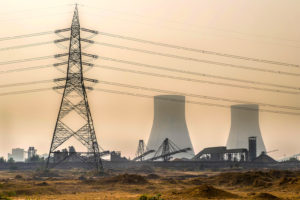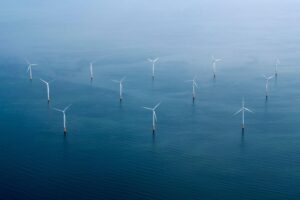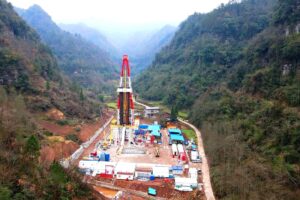From tree-planting to spreading silicate rock dust over land, the methods for “carbon dioxide removal” (CDR) vary in approach, impacts, readiness and cost.
The second “State of CDR” report, led by a collaboration of scientific institutions from Europe and the US, aims to summarise where the world currently stands when it comes to removing CO2 from the air.
The report covers everything from how many tonnes are currently being “drawn down” from the atmosphere and stored through to the development of research grants, policies and media coverage.
Scientists are clear that countries must cut their emissions as fast as possible to reach climate goals.
But the use of CDR to counterbalance emissions that are difficult to eliminate completely, such as methane from rice farming, will be “unavoidable” if the world is to reach net-zero, according to the Intergovernmental Panel on Climate Change (IPCC).
However, some environmental groups have concerns that highly polluting companies and countries view CDR as an alternative to reducing emissions, with one activist describing reports such as this as a “dangerous distraction”.
Carbon Brief has trawled through the new report’s 222 pages and pulled out nine key takeaways, focusing on the updates since last year’s report.
- ‘Novel’ CDR is growing more rapidly than conventional methods, despite downward revision
- The report identifies a new subset of future scenarios that take sustainable development into account
- There continues to be a CDR ‘gap’ to the Paris temperature goal
- Innovation is generally intensifying, but with some recent slowdowns
- There has been ‘steady growth’ in CDR research grants
- On social media, the focus on different CDR methods has changed over the past 12 years
- Media coverage of CDR tends to peak around COPs
- Policies are needed that create demand for carbon removals
- Monitoring, reporting and verification is ‘essential’ for scaling up CDR, but there are dozens of different protocols
‘Novel’ CDR is growing more rapidly than conventional methods, despite downward revision
There are many ways to remove CO2 from the atmosphere. These methods have “different levels of readiness, potential and durability” and various “sustainability risks that could limit their deployment”, the report says.
CDR techniques, also known as “negative emissions”, already remove 2bn tonnes of CO2 from the atmosphere each year, the report says, versus the 40bn tonnes that human activities emit each year.
Almost all of this comes from “conventional” CDR methods. “Conventional” methods are those that are “well established” and “widely reported” by countries as part of land use, land-use change and forestry activities (often referred to as “LULUCF”), chiefly through tree-planting and forest restoration.
Early-stage or “novel” CDR methods currently remove a much smaller 1.3m tonnes of CO2 each year – less than 0.1% of total CDR.
This is demonstrated in the graphic below, which compares “conventional” CDR (grey) to “novel” techniques (yellow to black).
“Novel” techniques include bioenergy with carbon capture and storage (BECCS), a technology where plants are burned for energy, with the CO2 emitted captured from air and stored under land or sea.
It also includes “biochar”, which involves spreading charcoal over land to boost soil carbon, and “enhanced rock weathering”, which involves spreading finely ground silicate rock over land or sea to enhance the natural weathering process.

Despite making up the smallest proportion of CDR, “novel” techniques are growing faster than “conventional” methods, in terms of tonnes of CO2 removed each year.
“Novel” CDR removed 660,000 tonnes of CO2 in 2021 and 1.35m tonnes of CO2 in 2023, the report says.
However, the estimate for “novel” CDR in 2023 is smaller than it was projected to be in the first edition of the state of CDR report.
This is due to “improved estimation methods” in the new state of the climate report, which are in alignment with the methods used by the Global Carbon Budget, the authors say.
The report says that countries with the highest levels of CDR through tree-planting and forest restoration are China, the US, Brazil and Russia. If the EU27 were a country, it would be the first or second largest nation for tree-planting.
Based on available data, the country with the largest contribution to novel CDR is the US, as it hosts all the BECCS plants that are currently in operation, the report adds.
The report identifies a new subset of future scenarios that take sustainable development into account
Under the Paris Agreement, countries agreed to limit global warming to well below 2C above pre-industrial levels, with an ambition of keeping them at 1.5C.
Scientists have devised a range of possible scenarios for how the world could keep temperatures at 1.5C. All of these scenarios feature some level of CDR, the report notes.
The report says that, although the Paris Agreement states that climate action must be done “in the context of sustainable development”, most scenarios do not explicitly consider social and environmental sustainability.
For the first time this year, the report identified a subset of scenarios that could be considered “more sustainable”.
The authors considered a scenario to be “sustainable” if it involved:
- Halting deforestation and ecosystem degradation, as well as protecting biodiversity.
- Reducing the number of people at risk from hunger.
- Limiting the growth of global energy demand, while enhancing equitable access to energy.
- Limiting reliance on energy from biomass, to reduce pressure on land and water.
- Keeping temperature rise well below 2C, striving to limit it to 1.5C.
Across this group of “sustainable” 1.5C scenarios, a central range of 7-9bn tonnes of CO2 will need to be removed each year by 2050, the report says.
It adds that “sustainable” scenarios “deploy less cumulative CDR and much less novel CDR than other mitigation scenarios”.
The chart below shows the amount of CO2 removed each year between 2020 and 2050 under a range of 1.5C-consistent scenarios.
It highlights three “focus scenarios” for meeting 1.5C in a “sustainable way”. This includes one focused on energy demand reduction, one on boosting renewable generation and one on expanding conventional and novel CDR.

There continues to be a CDR ‘gap’ to the Paris temperature goal
The report says that there is still a “gap” between the amount of CDR included in 1.5C-consistent pathways and the amount pledged by countries in their national climate plans, known as “nationally determined contributions” (NDCs), and long-term strategies.
Compared to the last edition, this report considers a wider range of national pledges on CDR, including pledges made up until the COP28 climate summit in Dubai in 2023.
The charts below illustrate the size of the CDR gap in 2030 and 2050, by showing the level of proposed CDR (light grey) and the level needed in various 1.5C-consistent pathways (yellow).

It illustrates that the size of the CDR gap depends on how much CDR is used to reach 1.5C. (This was the subject of a recent research paper covered by Carbon Brief.)
The CDR gap is small when the most ambitious national proposals are compared with levels in the “1.5C with no novel CDR scenario”, the report says.
Out of three scenarios shown on the chart above, the CDR gap ranges in size between 900m tonnes and 2.8bn tonnes of CO2 per year in 2030 and 400m tonnes and 5.4bn tonnes per year in 2050.
The report adds that, compared to its own estimates, the “actual gap is likely higher”. This is because “scenarios assume that significant emission reductions are already taking place, when in fact global emissions have continued to rise”.
Innovation is generally intensifying, but with some recent slowdowns
The report uses various “indicators of innovation” to show that CDR activity is “generally intensifying, although with some recent slowdowns”.
The report points to the continued rapid growth in published scientific research on CDR, as well as the launch of “major” demonstration programmes.
These include the Regional Direct Air Capture Hubs in the US – which have been allocated $3.5bn in funding through president Joe Biden’s Bipartisan Infrastructure Law – and Mission Innovation, an international initiative that includes a goal to “enable CDR technologies to achieve a net reduction of 100m metric tonnes of CO2 per year globally by 2030”.
The report notes that although new CDR patents “experienced rapid growth between 2000 and 2010”, they have since started to decline. However, it adds, patents “have become more diverse and novel methods play a larger role”.
The figure below summarises these findings, showing the changing counts of research grants, publications and inventions (right), as well as the split between different regions (left) and CDR methods (middle).

There is a similarly mixed bag of progress in other indicators. For example, on CDR startup companies, the report says:
“Investment in CDR startups has grown significantly over the past decade, outpacing the climate-tech sector as a whole – although it declined in 2023, and CDR accounts for just 1.1% of investment in climate-tech start-ups.”
The report notes that direct air carbon capture and storage (DACCS) has “become a primary focus for corporate and other large investors in CDR”, adding:
“Major CDR startups such as Climeworks and Carbon Engineering have received investments from corporations that are looking to offset emissions from their core business (e.g. Microsoft, Airbus, Chevron, JP Morgan).”
The report also concludes that CDR companies and industry groups have announced capacity targets that “show ambition to reach, by mid-century or sooner, levels of CDR consistent with meeting the Paris temperature goal”. However, it adds, they have “little grounds for credibility at present”.
There has been ‘steady growth’ in CDR research grants
The report includes – for the first time – analysis of research grants that have been awarded for CDR as one of its indicators of innovation.
This analysis uses the Dimensions database of research projects granted by third-party funding bodies, which includes the number of projects and – in about three-quarters of cases – the amount of funding.
Between 1991 and 2022, the analysis identifies grants from 131 funding organisations, such as research councils, foundations and philanthropic groups. (The data only covers specific grants, not funding coming through an institution’s central budget.) These grants went to around 1,600 research organisations and total around $2.6bn, the report estimates.
As the chart below illustrates, both the quantity (yellow bars) and value (grey) of grants have “grown steadily” in recent years. The report says:
“The number of research grants for CDR has grown from 35 active grants during 2000 to 1,160 during 2022…About 74% of all research grants on CDR in the data set started within the last 10 years (2013-22).”
The annual value of grants has grown from about $5m in 2000 to about $190m in 2022, the report adds.

Almost 70% of all active CDR research grants over 2000-22 focus on soil carbon sequestration (35%) or biochar (33%), the report says. Although, as the chart below shows, grants “have been diversifying over time”, with an increasing share for other methods by 2022, such as DACCS (11%), peatland restoration (8%), coastal wetland restoration (7%), enhanced rock weathering (5%) and BECCS (5%).

The majority of research investment is in Canada and the US, the report says. The two countries account for 40% of all active research grants between 2000 and 2022 and 59% of the funding.
The 27 countries of the EU collectively account for around 19% of CDR funding, the report says, while just three non-EU countries – Norway, Switzerland and the UK – together account for 11%. Meanwhile, it adds, China “funds many CDR projects, but the financial support reported is comparatively small”.
On social media, the focus on different CDR methods has changed over the past 12 years
The second edition of the report includes an update to its analysis of how CDR is discussed on Twitter. This includes extending its dataset to the end of 2022 and adding “new data on user types and posting frequency”.
In total, the dataset covers 570,000 English-language tweets over 2020-22 (and does not include retweets). The authors used machine learning to classify whether the tone of the tweets were positive, negative or neutral.
Overall, the report finds that the amount of attention that CDR received from English-speaking Twitter accounts in 2022 was similar to 2021, but “with generally more positive sentiment towards familiar and conventional CDR methods than to other methods”.

Looking across the whole time period, the authors find that “earlier tweets mainly focused on specific CDR methods, such as soil carbon sequestration, coastal wetland restoration, ocean fertilisation, afforestation and biochar”. They add that “recent years have seen an increase in the share of tweets about CDR in general, as well as an expansion to novel CDR methods such as DACCS and BECCS”.
The analysis also finds that CDR tweets have become more positive over time. For example, “tweets on biological capture methods have a positive sentiment much more often than a negative sentiment, aligning with the survey literature on perceptions”, the report says.
The majority of tweets (70%) come from users in Australia, Canada, the UK and the US, the report finds, but also from those in Belgium, Chile, France, Germany, Ghana, India, Norway and Switzerland. The report notes that “sentiments tend to be more negative in Australia, Canada and Germany than in India, the UK and the US”.
The authors also find differences in which CDR methods are being tweeted about. They write:
“For example, users from Australia, India and the US post more about soil carbon sequestration than others. UK users post more about peatland restoration and coastal wetland restoration, while Ghanian users focus on biochar and general CDR.”
Media coverage of CDR tends to peak around COPs
The report includes new analysis of how CDR has been reported in English-speaking media around the world over the past three decades.
The chart below illustrates how CDR reporting has increased since 1990. The analysis of more than 9,000 articles shows that the “main period of media reporting” started in 2007.

The authors identify a “major increase” in CDR news coverage from 2019, peaking in the run up to the COP26 climate summit in Glasgow in 2021 as countries updated their Paris Agreement pledges. They write:
“Since many of these targets included net-zero pledges, the resulting climate policy discourse tended to feature CDR prominently.”
For much of the three-decade period, peaks in CDR reporting have coincided with climate summits, the report adds, including “COP13 in Bali in 2007, where several international forestry initiatives were announced; and COP6 in The Hague in 2000, where the role of forests as carbon sinks first sparked significant debate under the UNFCCC process”.
Mentions of CDR in the news are “relatively concentrated in specific news media and countries”, the report notes. As the upper chart below shows, Australian and UK press dominate coverage, accounting for eight of the top 10 sources for most articles.
The lower chart shows a breakdown of which CDR methods tend to feature in news articles for individual countries. Soil carbon sequestration features heavily in Australia, the authors note, “reflecting its higher state of integration into Australian climate policy”.
Elsewhere, peatland restoration is “more prominent in the Irish and UK press”, the report says, while afforestation and coastal wetland restoration have larger shares in India and Pakistan.

Further analysis of a random sample of 1,500 news articles suggests that CDR reporting tends to “intersect with other concepts and mitigation approaches, including (fossil-based) carbon capture and storage [CCS], carbon capture and utilisation [CCU] (e.g. synthetic fuel production, biofuels) and avoided emissions (e.g. forest carbon offsets)”.
The authors add:
“Journalists do not necessarily distinguish between these different categories of mitigation, yet it is important to communicate the specific role of CDR as distinct from emission reduction efforts.”
Policies are needed that create demand for carbon removals
The report says that, in order to increase CDR innovation and scale-up, “policies
are needed that create demand for carbon removals”.
It says that “CDR policy gained momentum in 2023”. It observed “active efforts” in many countries for “technology push policies”, including research projects and demonstration schemes.
However, it says that “demand-pull policies”, those aimed at creating demand for CDR, “remain weak”.
NDCs contain “few mentions of policies that could create a significant demand for CDR”, it says, and “monitoring, reporting and verification (MRV), which is important for facilitating transactions in CDR markets, is not fully developed at present”.
When compared to action from policymakers, the voluntary carbon market is “playing a key role in scaling up CDR”, the report says.
The voluntary carbon market is a place where polluting businesses can buy credits from carbon-cutting projects, allowing the firms to claim they reduced their own emissions. It has been much criticised by researchers for failing to live up to promises to cut emissions.
Carbon Brief analysis shows that just 3% of carbon credits for sale on the four largest voluntary offset registries are for CDR projects, with the rest being for “avoided emissions” projects.
The first edition of the state of CDR report includes case studies for CDR policies in Brazil, EU, US and UK. The second edition includes new case studies for Canada, China, Japan and Saudi Arabia.
Monitoring, reporting and verification is ‘essential’ for scaling up CDR, but there are dozens of different protocols
The report notes that monitoring, reporting and verification (MRV) for CDR is “critical” for ensuring that CO2 has been captured from the atmosphere and stored durably. The report defines MRV as the process of:
- Measuring or quantifying CO2 removals from a CDR activity and monitoring those CO2 removals over the course of a CDR activity.
- Reporting on those removals.
- Receiving third-party verification of the removals that have been reported.
Approaches to MRV are described in “protocols”, which the report defines as any document that outlines methods or sets quality requirements or guidelines for certification.
Robust MRV is “crucial” for “effective voluntary carbon markets, government-created markets, regulations and national reporting”, the authors say. However, at the moment, there are “many overlapping protocols, which makes comparison and oversight of CDR difficult for investors and governments alike”.
The report identifies 102 MRV protocols for CDR, which are shown in the chart below according to the year in which they were developed.
The authors note that 63% are for conventional CDR, 65% are for voluntary markets and 58% are for international activities. Some 40% have been developed since 2022.

Across the world, “Europe (including the UK) accounts for 44% of total MRV protocol development, North America makes up 42%, Oceania 5%, Asia 4%, Latin America 3% and Africa 2%”, the report says.
MRV policymaking differs across these jurisdictions, it notes:
“For example, the EU and the UK have prioritised developing CDR standards and guidelines; the US, meanwhile, has focused on scaling up market-ready CDR and developing MRV tools for specific applications, such as marine CDR. The voluntary carbon market has played a leading role, with projects developing methods for monitoring, reporting and verifying CDR projects.”
In addition, there are different MRV challenges for each CDR method, the authors say:
“For novel CDR, more research is needed to develop and test MRV technology, including at large-scale demonstration sites.”
One challenge for novel CDR methods, such as DACCS, is that they often use proprietary techniques that are not publicly available. Their MRV protocols are, therefore, “inaccessible”, the authors say, and so it is not possible to compare them with those that are public.
For conventional CDR, “questions persist” around designing flexible MRV approaches that can accommodate different contexts, scales and approaches, the report says.
While the authors describe the current lack of IPCC greenhouse gas guidance methodologies for most novel CDR methods as a “major gap”, they note that the planned IPCC methodology report on CDR, CCS and CCU “is expected to outline a framework for including novel CDR methods in national inventories”.
This framework “will likely guide best practice in the voluntary carbon market and the development of national policies”, the study says.
The post Nine key takeaways about the ‘state of CO2 removal’ in 2024 appeared first on Carbon Brief.
Greenhouse Gases
DeBriefed 10 October 2025: Renewables power past coal; Legacy of UK’s Climate Change Act; Fukushima’s solar future
Welcome to Carbon Brief’s DeBriefed.
An essential guide to the week’s key developments relating to climate change.
This week
Renewables overtake coal
‘HISTORIC FIRST’: Renewables have overtaken coal to become the world’s leading source of electricity for the first six months of this year in a “historic first”, BBC News said. The analysis, from the thinktank Ember, found the world generated “almost a third” more solar power in the first half of the year, compared with the same period in 2024, while wind power grew by “just over 7%,” reported the Guardian.
HEAVY LIFTING: According to the report, China and India were “largely responsible for the surge in renewables”, while the US and Europe “relied more heavily on fossil fuels,” the Guardian wrote. China built more renewables than every other country combined in the first half of this year, the newspaper added.
CONTINENTAL SHIFTS: A second report from the International Energy Agency (IEA) predicted a “surge” in global wind and solar capacity by 2030, but shaved 5% off its previous forecast, the Financial Times said. The IEA revealed that India is set to become the second-largest growth market for renewables after China, “with capacity expected to increase 2.5 times by 2030”, Down to Earth reported. The IEA also upped its forecast for renewables in the Middle East and north Africa by 23%, “helped by Saudi Arabia rolling out wind turbines and solar panels”, but halved the outlook for the US, the FT noted.
Around the world
- EV BOOM: Sales of electric and hybrid cars made up “more than half” of all new car registrations in the UK last month, a new record, according to data from the Society of Motor Manufacturers, reported BBC News.
- BANKING COLLAPSE: A global banking alliance launched by the UN to get banks to slash the carbon footprint of their loans and investments and help drive the transition to a net-zero economy by 2050 has collapsed after four years, Agence France-Press reported.
- CUTS, CUTS, CUTS: The Trump administration plans to cut nearly $24bn in funding for more than 600 climate projects across the US, according to documents reviewed by the Wall Street Journal.
- PEOPLE POWER: A farmer, a prison guard and a teacher were among those from the Dutch-Caribbean island Bonaire who appeared at the Hague on Tuesday to “accuse the Netherlands of not doing enough to protect them from the effects of climate change”, Politico reported.
400,000
The number of annual service days logged by the US National Guard responding to hurricanes, wildfires and other natural disasters over the past decade, according to a Pentagon report to Congress, Inside Climate News reported.
Latest climate research
- Politicians in the UK “overwhelmingly overestimate the time period humanity has left to bend the temperature curve”, according to a survey of 100 MPs | Nature Communications Earth and Environment
- Fire-driven degradation of the Amazon last year released nearly 800m tonnes of CO2 equivalent, surpassing emissions from deforestation and marking the “worst Amazon forest disturbance in over two decades” | Biogeosciences
- Some 43% of the 200 most damaging wildfires recorded over 1980-2023 occurred in the last decade | Science
(For more, see Carbon Brief’s in-depth daily summaries of the top climate news stories on Monday, Tuesday, Wednesday, Thursday and Friday.)
Captured

The UK’s Climate Change Act, landmark legislation that guides the nation’s response to climate change, is increasingly coming under attack from anti-net-zero right-leaning politicians. In a factcheck published this week, Carbon Brief explained how the UK’s Climate Change Act was among the first comprehensive national climate laws in the world and the first to include legally binding emissions targets. In total, 69 countries have now passed “framework” climate laws similar to the UK’s Climate Change Act, with laws in New Zealand, Canada and Nigeria among those explicitly based on the UK model. This is up from just four when the act was legislated in 2008. Of these, 14 are explicitly titled the “Climate Change Act”.
Spotlight
Fukushima’s solar future
This week, Carbon Brief examines how Fukushima helped to recover from nuclear disaster by building solar farms on contaminated farmland.
On 11 March 2011, an earthquake off the pacific coast of Japan caused 15m-tall waves to crash into the eastern region of Tōhoku, killing 19,500 people and injuring a further 6,000.
In the aftermath, flooding at the Fukushima Daichi nuclear power plant caused cooling systems to fail, leaching radioactive contaminants into the soil and leading to a major nuclear incident.
Some 1,200km2 around the site was restricted and up to 100,000 people were evacuated – in some cases forever.
In the years following, Japan entered a fraught debate about nuclear energy.
In 2010, nuclear power provided 25% of Japan’s electricity, but, in the years following the disaster, its 54 nuclear reactors were taken offline.
Successive governments have fought over reintroducing nuclear power. Today, some 14 reactors are back online, 27 have been permanently closed and another 19 remain suspended. (Japan’s newly-elected prime minister Sanae Takaichi has promised to make nuclear central to her energy strategy.)
Against this backdrop, Fukushima – a prefecture home to 1.8 million people – has emerged as a surprise leader in the renewables race.
In 2014, the Fukushima Renewable Energy Institute (FREA) opened with the twin goals of promoting research and development into renewable energy, while “making a contribution to industrial clusters and reconstruction”.
That same year, the prefecture declared a target of 100% renewable power by 2040.
Contaminated land
“A lot of these communities, I know, were looking for ways to revitalise their economy,” said Dr Jennifer Sklarew, assistant professor of energy and sustainability at George Mason University and author of “Building Resilient Energy Systems: Lessons from Japan”.
Once evacuation orders were lifted, however, residents in many parts of Fukushima were faced with a dilemma, explained Skarlew:
“Since that area was largely agricultural, and the agriculture was facing challenges due to stigma, and also due to the soil being removed [as part of the decontamination efforts], they had to find something else.”
One solution came in the form of rent, paid to farmers by companies, to use their land as solar farms.
Michiyo Miyamoto, energy finance specialist at the Institute for Energy Economics and Financial Analysis, told Carbon Brief:
“The [Fukushima] prefecture mapped suitable sites early and conducted systematic consultations with residents and agricultural groups before projects were proposed. This upfront process reduced land-use conflicts, shortened permitting timelines and gave developers clarity.”
As a result, large-scale solar capacity in Fukushima increased to more than 1,300 megawatts (MW) from 2012 to 2023, according to Miyamoto. Moreover, installed renewable capacity now exceeds local demand, meaning the region can run entirely on clean power when conditions are favourable, Miyamoto said.
Today, aerial pictures of Fukushima reveal how solar panels have proliferated on farmland that was contaminated in the nuclear disaster.

Charging on
Last year, 60% of Fukushima’s electricity was met by renewables, up from 22% in 2011. (The country as a whole still lags behind at 27%.)
And that is set to grow after Japan’s largest onshore windfarm started operations earlier this year in Abukuma, Fukushima, with a capacity of 147MW.
The growth of solar and wind means that Fukushima is already “ahead of schedule” for its 2040 target of 100% renewable power, said Miyamoto:
“The result is a credible pathway from recovery to leadership, with policy, infrastructure and targets working in concert.”
Watch, read, listen
OVERSHOOT: The Strategic Climate Risks Initiative, in partnership with Planet B Productions, has released a four-part podcast series exploring what will happen if global warming exceeds 1.5C.
DRONE WARFARE: On Substack, veteran climate campaigner and author Bill McKibben considered the resilience of solar power amid modern warfare.
CLIMATE AND EMPIRE: For Black history month, the Energy Revolution podcast looked at how “race and the legacies of empire continue to impact the energy transition”.
Coming up
- 12 October: presidential elections, Cameroon
- 13-14 October: Pre-COP, Brasilia, Brazil
- 13-18 October: World Bank Group/IMF annual meetings, Washington DC
- 14-17 October: 2nd extraordinary session of the Marine Environment Protection Committee at the International Maritime Organisation, London
- 15-16 October: Circle of Finance Ministers report
Pick of the jobs
- Buckinghamshire Council, principal climate change officer | Salary: £49,354-£51,759. Location: Aylesbury, Buckinghamshire
- Sustainable NI, sustainable business lead | Salary: £60,000. Location: Belfast, Northern Ireland
- Dialogue Earth, South Asia managing editor | Salary: £1,875 per month. Location: South Asia
DeBriefed is edited by Daisy Dunne. Please send any tips or feedback to debriefed@carbonbrief.org.
This is an online version of Carbon Brief’s weekly DeBriefed email newsletter. Subscribe for free here.
The post DeBriefed 10 October 2025: Renewables power past coal; Legacy of UK’s Climate Change Act; Fukushima’s solar future appeared first on Carbon Brief.
Greenhouse Gases
Guest post: How Caribbean states are shifting climate legislation
The Caribbean region is among the most vulnerable to climate change, despite historically contributing less than half of one percent of global greenhouse gas emissions.
Rising sea levels, extreme heat and more frequent and intense storms – such as the 2024 Hurricane Beryl, which made landfall in Grenada – pose urgent and growing threats to the small island states, coastal nations and overseas territories that comprise the Caribbean region.
With global progress to address climate change still too slow, Caribbean countries are taking matters into their own hands by enacting more robust legislation to help protect against climate risks.
In a new study published in the Carbon and Climate Law Review, we identified 78 climate laws and legally binding decrees across 16 Caribbean states, as well as two constitutional references to climate change and a growing recognition of the right to a healthy environment.
Our analysis suggests that, together, these developments are not only enhancing resilience, but also positioning Caribbean states as influential actors in the global climate arena.
Caribbean climate laws on the rise
Climate governance in the Caribbean has expanded significantly in recent years. In the past decade, countries such as Cuba and the Dominican Republic have embedded climate obligations and programmatic guidelines into their national constitutions.
At the same time, legislative recognition of the human right to a healthy environment is gaining momentum across the region. Six Caribbean nations now affirm the right in their constitutions, while 15 have recognised it through international instruments, such as the UN Council, UN Assembly and the Escazu Agreement, as shown in the figure below.
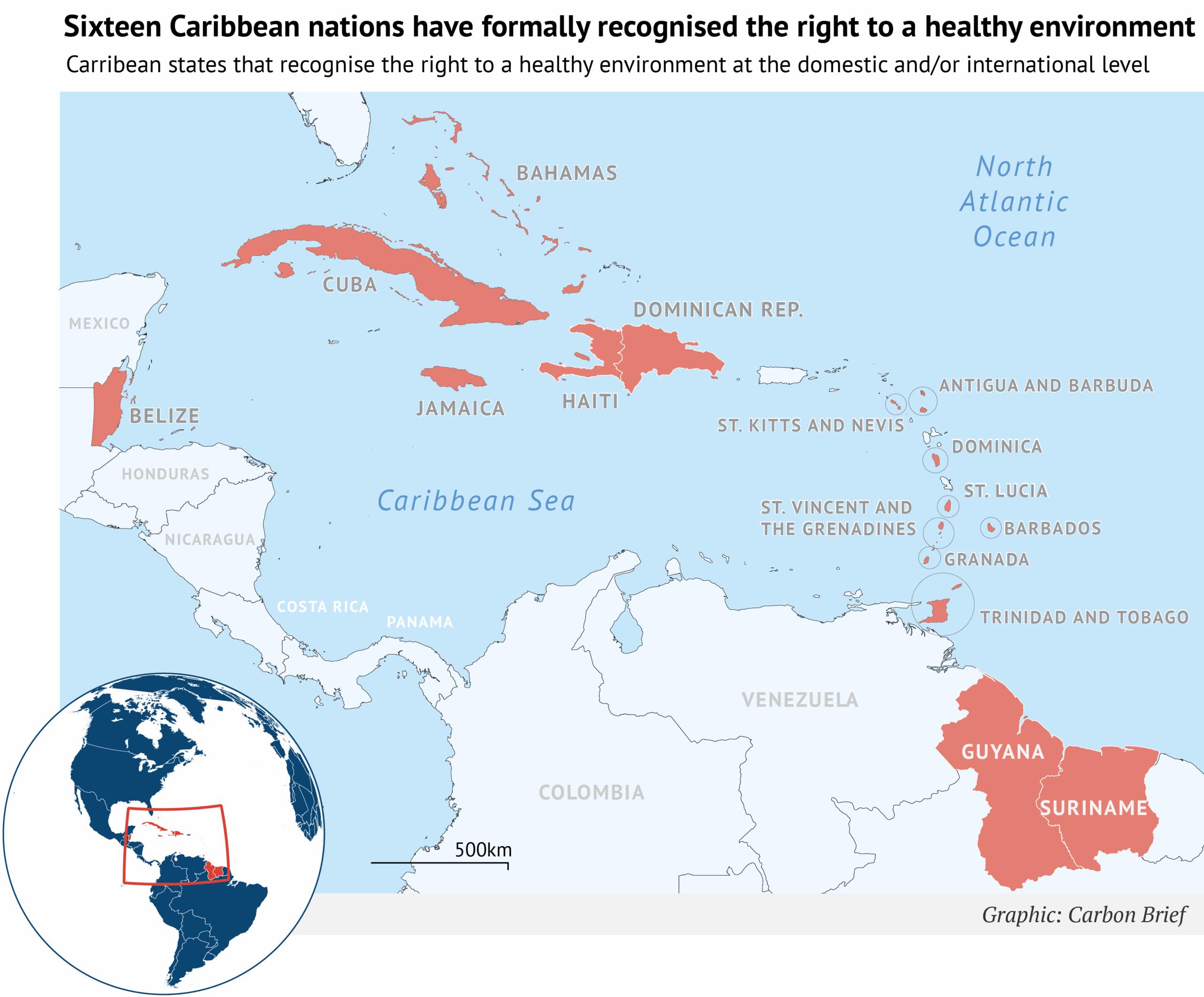
More recently, there has been a notable rise in targeted, sector-specific climate frameworks that go beyond broader environmental statutes.
Saint Lucia stands out as the only country with a climate framework law, or a comprehensive national law that outlines long-term climate strategies across multiple domains. Meanwhile, several other Caribbean governments have adopted climate-specific laws that focus on individual sectors, such as energy, migration and disaster management.
According to our analysis, more than a quarter of climate-relevant legislation in the region – comprising 21 laws and legally binding decrees – now has an explicit focus on climate change, as illustrated in the chart below.
Our research suggests that this represents an ongoing shift in legislative focus, reflecting changes in how climate legislation is being structured in one of the world’s most climate-vulnerable regions.
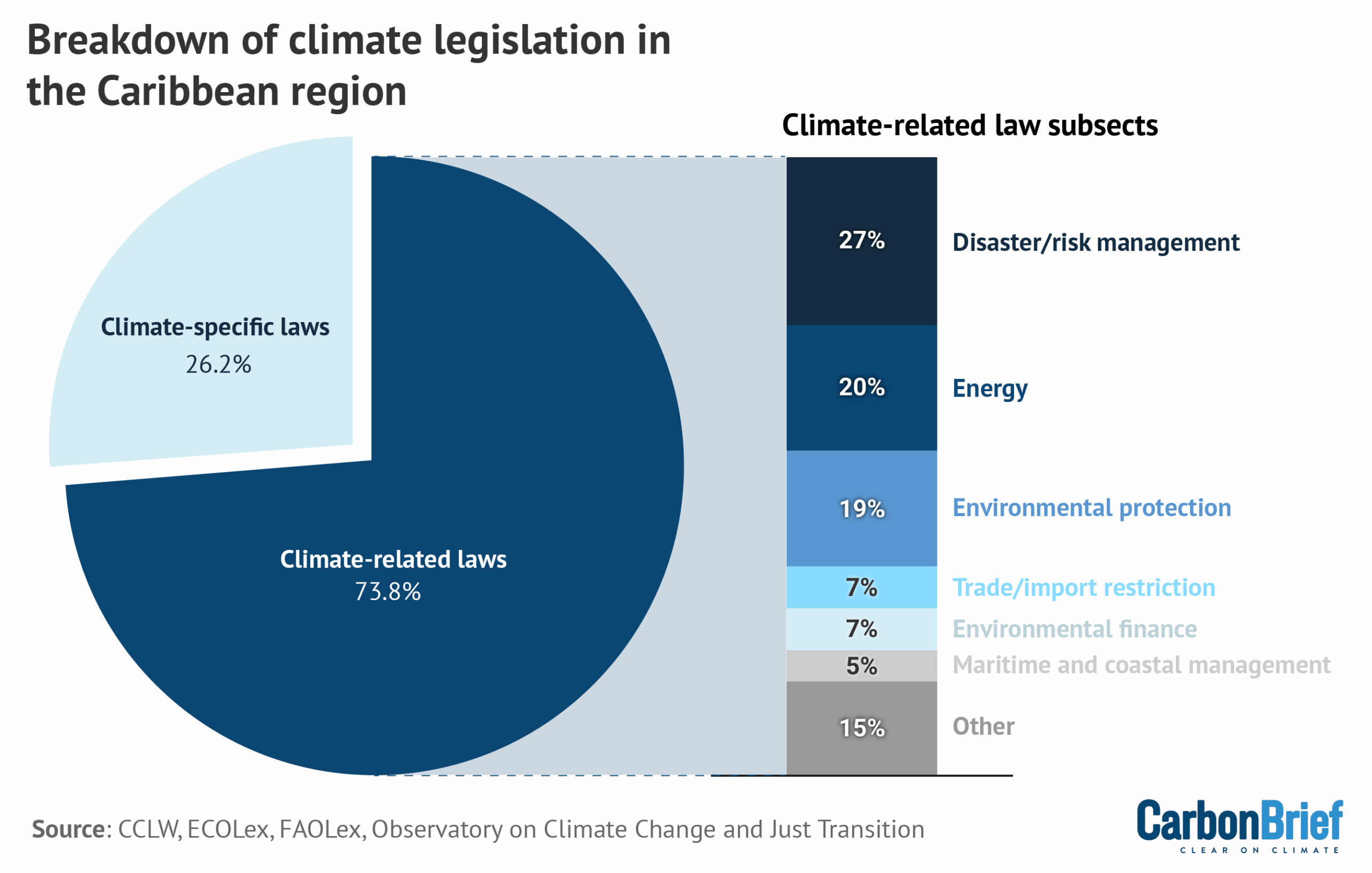
Caribbean nations are also advancing legal reforms to structure and institutionalise climate finance and market mechanisms directly into domestic law, aligned with Article 6.2 of the Paris Agreement.
For example, the Bahamas has introduced provisions for carbon credit trading, while Antigua and Barbuda, Barbados and Grenada have established national climate financing mechanisms to support mitigation and adaptation efforts.
Some states, including Belize and Saint Kitts and Nevis, have incorporated regional bodies such as the Caribbean Community Climate Change Centre – the climate arm of the intergovernmental Caribbean community organisation CARICOM – into national frameworks. This indicates an increasing alignment between regional cooperation and domestic law.
In addition to the influx of regulations specifically addressing climate change, Caribbean nations are also legislating broader environmental issues, which, in turn, could provide increased resilience from climate impacts and risks, as shown in the graph above.
Key trends in these types of climate-related laws include the expansion of disaster risk management governance, which addresses national preparedness for climate-induced weather events or related catastrophes. Likewise, energy law is an increasingly prominent focus, with countries including Antigua and Barbuda and Saint Vincent and the Grenadines integrating renewable energy and energy efficiency goals into national climate governance.
More broadly, many Caribbean nations have adopted wide-ranging and comprehensive environmental laws, many of which were developed in alignment with existing climate commitments. In combination, these legal developments reflect a dynamic and evolving climate governance landscape across the region.
Proactive vs reactive approaches
Despite general alignment with these broader regional trends, our research reveals distinct developmental pathways shaping domestic climate regulation.
In the eastern Caribbean, for example, we saw both proactive, long-term planning strategies and reactive, post-disaster reforms.
Saint Lucia’s multifaceted approach to climate resilience evolved steadily over the course of more than a decade. During this time, the country developed numerous adaptation plans, strengthened cross-sectoral coordination and engaged in institutional climate reforms in areas such as energy, tourism, finance and development.
More recently, the passage of Saint Lucia’s Climate Change Act in 2024 marked a milestone in climate governance, by giving legal force to the country’s obligations under the UNFCCC, the Kyoto Protocol and the Paris Agreement – making Saint Lucia one of the few small island states to incorporate global climate commitments into domestic law.
Our research indicates that this strategy has not only positioned the country as a more climate-resilient nation, but also solidified its access to international climate financing.
In contrast, Dominica’s efforts evolved more rapidly in the aftermath of Hurricane Maria in 2017, which destroyed over 200% of the country’s GDP. The storm’s impacts were felt across the country and hit particularly hard for the Kalinago people – the Caribbean’s last Indigenous community – highlighting the role of socioeconomic disparities in shaping climate vulnerability and resilience.
In response, the government passed the Climate Resilience Act, creating the temporary Climate Resilience Execution Agency for Dominica (CREAD).
Beyond establishing an exclusively climate-focused institution, the act aimed to embed resilience into governance by mandating the participation of vulnerable communities – including Indigenous peoples, women, older people and people with disabilities – in shaping and monitoring climate resilience projects.

As noted in a recent statement by the UN special rapporteur on Climate Change, Dr Elisa Morgera, these frameworks underscore the government’s ambition to become the world’s first “climate-resilient nation.”
Although challenges persist, Dominica’s efforts demonstrate how post-disaster urgency can drive institutional change, including the integration of rights and resilience into climate governance.
Uneven progress and structural gaps
Despite significant progress, our research shows that several key opportunities for climate governance across the Caribbean continue to exist, which could enable improvements in both resilience and long-term ambition.
The region’s legal landscape remains somewhat heterogeneous. While Saint Lucia has enacted a comprehensive climate framework law, the rest of the region lacks similar blanket legislation. This includes some states that entirely lack climate-specific laws, instead relying on related laws and frameworks to regulate and respond to climate-related risks.
Other nations have yet to adopt explicit disaster-risk management frameworks, leaving Caribbean populations vulnerable before, during and after climate emergencies. Most have yet to enshrine the right to a healthy environment at the national level.
Our research suggests that outdated legal frameworks are further limiting progress in addressing current climate risks. Because many of the longer-standing environmental laws in the region were adopted well before climate policy became a mainstream concern, some fail to address the nature, frequency and intensity of modern climate challenges, such as sea-level rise, tropical storms, wildfires, floods, droughts and other impacts.
More broadly, many Caribbean climate laws include limited integration of gender equity, Indigenous rights and social justice. As Caribbean nations such as Grenada and the Dominican Republic begin to link climate resilience with these issues, the region has an opportunity to lead by example.
Ultimately, capacity and resource constraints persist as significant barriers to implementation and adaptation.
The Caribbean region faces debt that exacerbates ongoing development challenges, a burden made heavier by the repeated economic shocks of climate-related disasters. Along with regional debt-for-resilience schemes, increased funding from high-emitting countries to support adaptation measures in climate-vulnerable nations – as endorsed under the Paris Agreement – is likely to be critical to ensuring the region’s climate laws can be executed effectively.
Global implications of Caribbean climate law
Our research suggests that Caribbean countries are outpacing other regions in terms of the scope and ambition of their climate laws. This legislation has the potential to serve as a model for climate-vulnerable nations worldwide.
Continuing efforts in the region show that legal frameworks in the field can not only drive resilience, embed rights and strengthen claims to international finance, but also highlight how regional cooperation and diplomacy can enhance global influence.
These findings demonstrate that innovation in climate law need not wait for action from major emitters, but can instead be led by those on the front lines of climate change.
The post Guest post: How Caribbean states are shifting climate legislation appeared first on Carbon Brief.
Guest post: How Caribbean states are shifting climate legislation
Greenhouse Gases
IEA: Renewables have cut fossil-fuel imports for more than 100 countries
More than 100 countries have cut their dependence on fossil-fuel imports and saved hundreds of billions of dollars by continuing to invest in renewables, according to the International Energy Agency (IEA).
It says nations such as the UK, Germany and Chile have reduced their need for imported coal and gas by around a third since 2010, mainly by building wind and solar power.
Denmark has cut its reliance on fossil-fuel imports by nearly half over the same period.
Renewable expansion allowed these nations to collectively avoid importing 700m tonnes of coal and 400bn cubic metres of gas in 2023, equivalent to around 10% of global consumption.
In doing so, the fuel-importing countries saved more than $1.3tn between 2010 and 2023 that would otherwise have been spent on fossil fuels from overseas.
Reduced reliance
The IEA’s Renewables 2025 report quantifies the benefits of renewable-energy deployment for electricity systems in fossil fuel-importing nations.
It compares recent trends in renewable expansion to an alternative “low renewable-energy source” scenario, in which this growth did not take place.
In this counterfactual, fuel-importing countries stopped building wind, solar and other non-hydropower renewable-energy projects after 2010.
In reality, the world added around 2,500 gigawatts (GW) of such projects between 2010 and 2023, according to the IEA, more than the combined electricity generating capacity of the EU and US in 2023, from all sources. Roughly 80% of this new renewable capacity was built in nations that rely on coal and gas imports to generate electricity.
The chart below shows how 31 of these countries have substantially cut their dependence on imported fossil fuels over the 13-year period, as a result of expanding their wind, solar and other renewable energy supplies. All of these countries are net importers of coal and gas.

In total, the IEA identified 107 countries that had reduced their dependence on fossil fuel imports for electricity generation, to some extent due to the deployment of renewables other than hydropower.
Of these, 38 had cut their reliance on electricity from imported coal and gas by more than 10 percentage points and eight had seen that share drop by more than 30 percentage points.
Security and resilience
The IEA stresses that renewables “inherently strengthen energy supply security”, because they generate electricity domestically, while also “improving…economic resilience” in fossil-fuel importer countries.
This is particularly true for countries with low or dwindling domestic energy resources.
The agency cites the energy crisis exacerbated by Russia’s invasion of Ukraine, which exposed EU importers to spiralling fossil-fuel prices.
Bulgaria, Romania and Finland – which have historically depended on Russian gas for electricity generation – have all brought their import reliance close to zero in recent years by building renewables.
In the UK, where there has been mounting opposition to renewables from right-wing political parties, the IEA says reliance on electricity generated with imported fossil fuels has dropped from 45% to under 25% in a decade, thanks primarily to the growth of wind and solar power.
Without these technologies, the UK would now be needing to import fossil fuels to supply nearly 60% of its electricity, the IEA says.
Other major economies, notably China and the EU, would also have had to rely on a growing share of coal and gas from overseas, if they had not expanded renewables.
As well as increasing the need for fossil-fuel imports from other countries, switching renewables for fossil fuels would require significantly higher energy usage “due to [fossil fuels’] lower conversion efficiencies”, the IEA notes. Each gigawatt-hour (GWh) of renewable power produced has avoided the need for 2-3GWh of fossil fuels, it explains.
Finally, the IEA points out that spending on renewables rather than imported fossil fuels keeps more investment in domestic economies and supports local jobs.
The post IEA: Renewables have cut fossil-fuel imports for more than 100 countries appeared first on Carbon Brief.
IEA: Renewables have cut fossil-fuel imports for more than 100 countries
-
Climate Change2 years ago
Spanish-language misinformation on renewable energy spreads online, report shows
-
Climate Change2 months ago
Guest post: Why China is still building new coal – and when it might stop
-
Climate Change Videos2 years ago
The toxic gas flares fuelling Nigeria’s climate change – BBC News
-

 Greenhouse Gases1 year ago
Greenhouse Gases1 year ago嘉宾来稿:满足中国增长的用电需求 光伏加储能“比新建煤电更实惠”
-
Greenhouse Gases2 months ago
Guest post: Why China is still building new coal – and when it might stop
-

 Climate Change1 year ago
Climate Change1 year ago嘉宾来稿:满足中国增长的用电需求 光伏加储能“比新建煤电更实惠”
-

 Carbon Footprint2 years ago
Carbon Footprint2 years agoUS SEC’s Climate Disclosure Rules Spur Renewed Interest in Carbon Credits
-
Renewable Energy3 months ago
US Grid Strain, Possible Allete Sale










